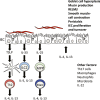Mucosal immune responses following intestinal nematode infection
- PMID: 25201407
- PMCID: PMC4312905
- DOI: 10.1111/pim.12090
Mucosal immune responses following intestinal nematode infection
Abstract
In most natural environments, the large majority of mammals harbour parasitic helminths that often live as adults within the intestine for prolonged periods (1-2 years). Although these organisms have been eradicated to a large extent within westernized human populations, those living within rural areas of developing countries continue to suffer from high infection rates. Indeed, recent estimates indicate that approximately 2.5 billion people worldwide, mainly children, currently suffer from infection with intestinal helminths (also known as geohelminths and soil-transmitted helminths) . Paradoxically, the eradication of helminths is thought to contribute to the increased incidence of autoimmune diseases and allergy observed in developed countries. In this review, we will summarize our current understanding of host-helminth interactions at the mucosal surface that result in parasite expulsion or permit the establishment of chronic infections with luminal dwelling adult worms. We will also provide insight into the adaptive immune mechanisms that provide immune protection against re-infection with helminth larvae, a process that is likely to be key to the future development of successful vaccination strategies. Lastly, the contribution of helminths to immune modulation and particularly to the treatment of allergy and inflammatory bowel disease will be discussed.
Keywords: geohelminth; immune-expulsion; intestinal helminth; mucosal immunity; nematode; type 2 immunity.
© 2013 The Authors. Parasite Immunology published by John Wiley & Sons Ltd.
Figures

References
-
- Bethony J, Brooker S, Albonico M, et al. Soil-transmitted helminth infections: ascariasis, trichuriasis, and hookworm. Lancet. 2006;367:1521–1532. - PubMed
-
- WHO. WHO Information Series on School Health-Document 1. Strengthening Interventions to Reduce Helminth Infections: An Entry Point for the Development of Health Promoting Schools. Geneva: WHO; 1997.
-
- WHO. Deworming for Health and Development: Report of the Third Partners for Parasite Control Meeting. Geneva: WHO; 2005.
-
- Pawlowski Z. Schad G and Stott G. Geneva: WHO; 1991.
Publication types
MeSH terms
Supplementary concepts
Grants and funding
LinkOut - more resources
Full Text Sources
Other Literature Sources

